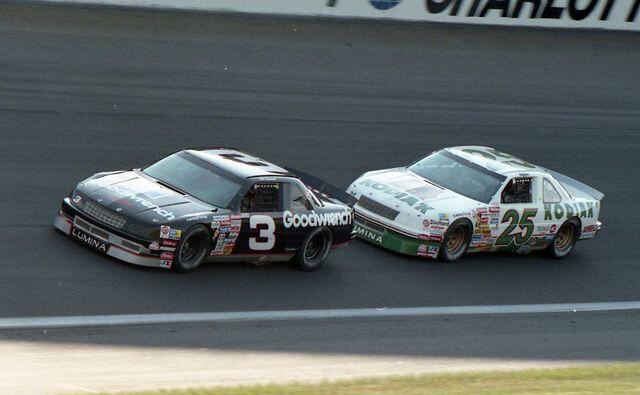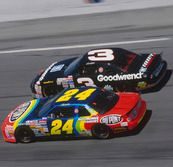May 20, 1990
Somebody is going home with $250,000 today.
It’s mid-May at Charlotte Motor Speedway, meaning that it’s time for NASCAR’s annual all-star weekend. For one race, the drivers of the Winston Cup series will throw caution to the wind and race like God intended. No points are on the line. No valuable championship positions can be won or lost. Only the win matters in this shootout for glory.
The Winston has undergone a notable change from years past. For the last few years, the event was a 135-lap, three-segment race that ended in a ten-lap shootout. Fans and drivers weren’t thrilled with the format, citing the lack of respectful driving that ended the previous year’s race. Rusty Wallace intentionally spun Darrell Waltrip to win the grand prize, leading to a brawl in the pits between each other’s crews. Aware of these issues, NASCAR has significantly tweaked the product for 1990. The main event will consist of a 50-lap sprint race, followed by a 20-lap shootout. Cash prizes will be made available for the winner of each segment.

20 drivers will have a chance to win these prizes. Regardless of year, the last 19 drivers to win a Winston Cup race are automatically qualified for the event. This can lead to some unique situations. Phil Parsons, the 1988 Winston 500 winner, has no ride for 1990 after losing his Morgan-McClure Motorsports seat. He’ll drive a one-off entry for Phil Barkdoll Racing, a team that has never qualified for the all-star race before.
The final spot in the main event will be decided by the Winston Open, a 134-lap preliminary race where anyone can enter. Only the winner of the event can advance to the Winston proper, so the racing is expected to be intense and unforgiving.
Qualifying for the Winston and the Open consists of hot laps followed by a full-speed pit stop. When all is said and done, Dale Earnhardt claims the top spot for the main event. For the open, Ernie Irvan continues his breakout year with the pole.
Ernie Irvan kicks off the festivities by jumping out to an early lead in the open. Following close behind is the favorite to advance to the main event: Greg Sacks. After his incredible run at Talladega, the journeyman has become the hottest commodity in NASCAR. Sacks hounds Irvan in the opening laps, eventually passing him as the caution comes out for Dick Johnson’s first of two crashes. Sacks holds steady on the restart before relinquishing the lead to Dick Trickle. He settles into second, holding off Irvan and keeping his eyes on the leading Pontiac of Trickle.
Dick Johnson’s bad day continues as he crashes hard on lap 50, bringing out the second caution of the day. Most of the leaders pit during this yellow, save for a few brave souls. Those who stay out include Dale Jarrett and Sterling Marlin, who dice for the lead on the restart. Sacks and Irvan are working their way back toward the front when disaster strikes. A blown tire on lap 76 sends Sacks flying into the outside wall at a bad angle. The impact is sickening, but thankfully Sacks survives without serious injury.
Avoiding the Sacks crash, Irvan scythes to the front once more. The polesitter appears to have the car to beat today, but his speed is fading the longer the race goes. Dick Trickle is catching Irvan for the lead when both are overtaken by a flash of blue. Rookie Rob Moroso makes a daring three-wide pass for the lead on lap 113. If the rookie can win this race, he’ll become the first rookie to make the main show since Davey Allison in 1987.
Trickle isn’t letting Moroso get too far ahead, pulling even with ten laps to go. The cagey veteran makes the pass, but Moroso stays close. With a lap to go, he makes his move, jutting to the inside for the pass. Trickle keeps his foot on the floor and holds the top, just barely keeping a nose ahead of Moroso coming to the line. By eight inches, Dick Trickle advances to the Winston.
Now is the point where I must bring up a common issue in certain sports. Have you ever tuned into a major boxing match only to watch as the main event is a huge letdown? Even though the undercard fights were must-watch TV?
That is exactly what happened with the 1990 Winston. After an exhilarating and incredible Open race, the main event falls short. Dale Earnhardt completely dominates, leading all 70 laps to become the first multi-time winner of NASCAR’s all-star race. Only Bill Elliott has a chance to catch Earnhardt after finishing close behind in the first stage. A botched restart for stage two ends any hope of Elliott upsetting the Intimidator.

Dale Earnhardt’s jubilation is well-deserved in victory lane. Along with the $250,000 prize, he also is in a rare company. Three drivers who have won the all-star race have gone on to win the series championship that same year. With three points-paying wins on the season along with this triumph, he’s set himself up for success.
But for the thousands of fans streaming out of Charlotte Motor Speedway, jubilation is the last thing they feel. What exactly did we just witness? How come the preliminary race was so thrilling, yet the main event was such a letdown? It’s the first truly ‘bad’ race of the 1990 season, yet it has been billed as THE race of the year. Was it the lack of cars on the track? Was the track set up improperly? Was Earnhardt just that much better? Did NASCAR make a mistake in changing the format?
One thing that is for sure is that for me at least, a race that lasts just 30 minutes isn’t worth it. Give me a race that lasts for hours with strategy, hard racing, a dash of chaos, and maybe a pinch of controversy.
Sounds like we need a 600-mile marathon.
Next time on NASCAR in the 90s, the longest race of the year takes center stage.
